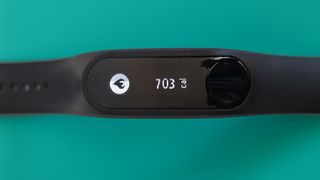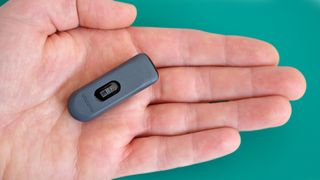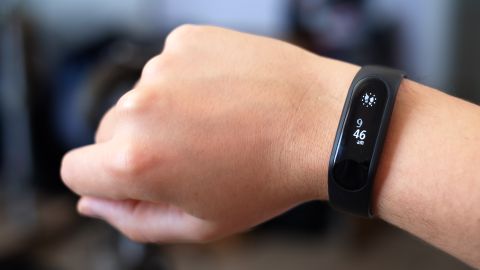Why you can trust TechRadar
Features and interface
- Simple but heavily paginated software
- One stat per screen layout
- Basic notifications
The TomTom Touch Cardio could be quicker and more reactive but this is typical of very simple fitness tracker software. There’s not much to remember here either, as the TomTom Touch Cardio is operated almost exclusively using up/down swipes and taps on the panel below the screen.
Wake the TomTom Touch Cardio up by pressing the main panel and you’ll see the clock face. A lot of the time, this is all you’ll need. It shows the time and a little graphic depicting how close you are to reaching your daily steps goal.
Above this screen there are two ‘active’ homepages. One starts tracking your heart rate, the other lets you track a specific activity, such as a run.
There’s no GPS in this band so you don’t actually get any metrics not covered by standard daily tracking. However, it does register this tracking period as a separate activity in the TomTom app, making it a good way to keep track of workouts.

Head below the watch face rather than above it and you’ll find a few pages that give you ongoing daily tracking stats. These are your step count, calories burnt, distance traveled, the number of minutes you’ve been active and how long you slept last night.
This covers just about everything you’d want to see from a fitness tracker that doesn’t have more advanced sensors like an altimeter or GPS. But given you can’t actually flick between them that quickly thanks to the slightly slow-moving interface, getting down to the bottom screen feels laborious.
It makes you wonder whether multiple stats could have been crammed into one screen. It’d push the 128 x 32 display to its limits, but as-is we’re frankly put off using about half of the interface screens.
There’s also a drop’s worth of smartwatch-like features to the TomTom Touch Cardio. The display shows an icon when you receive a call or text. However, as this doesn’t stretch to notifications from WhatsApp and other apps, you may not find this particularly useful.
Fitness tracking and performance
- Simple but solid metrics
- Fair HR performance
The TomTom Touch Cardio’s fitness tracking capabilities are limited. All its metrics are based on two sets of data: your heart rate and the number of steps taken.
There’s no altimeter, no GPS, so this isn’t really a tracker for someone training for a marathon. They’d be much better off with a TomTom Runner 3 or TomTom Spark 3, watches with GPS for much more accurate run tracking.
Compared with a phone tracking the same distances traveled from inside your pocket, the TomTom Touch Cardio records roughly 10% more steps. However, it’s within the normal accuracy range for a wrist-worn tracker.

Heart rate (HR) accuracy is reasonably good for a wrist model too. LifeQ makes the modules for these TomTom Touch models and they are very solid for analyzing resting heart rate, and not too bad for tracking during activity either.
It’s still a way off the accuracy of a chest strap sensor, but the results during a treadmill run are significantly better than those of some smartwatch HR sensors. It needs to bed in a while and can struggle with quick decreases in heart rate, but over a treadmill session you can get a decent read.
Current page: Specs, performance and fitness
Prev Page Introduction, design and display Next Page App, battery life and compatibilityAndrew is a freelance journalist and has been writing and editing for some of the UK's top tech and lifestyle publications including TrustedReviews, Stuff, T3, TechRadar, Lifehacker and others.


